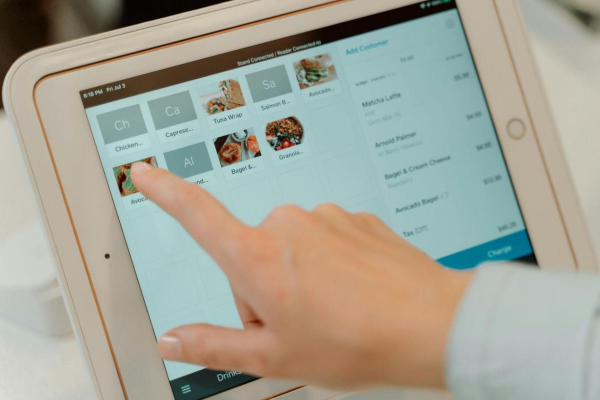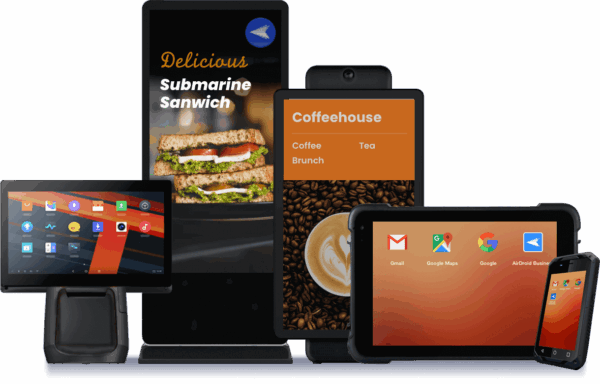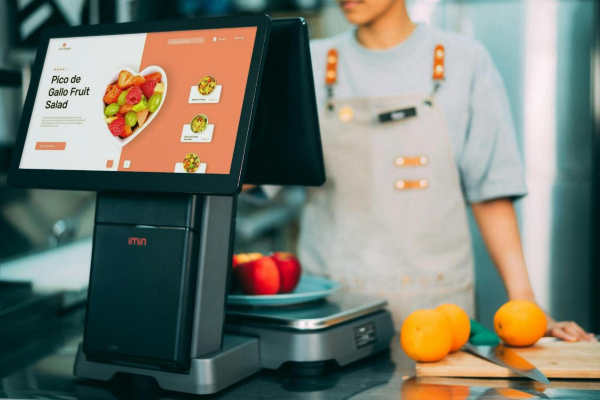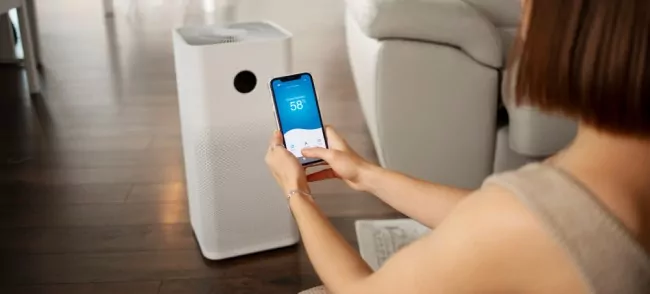Why Your Restaurant Needs a Self-Service Kiosk?
While many food and beverage leaders speak on the need for digital transformation, this call obscures what matters most. Customers want the ability to order independently, which explains why the self-service kiosk market is expected to grow to $23.07 billion by 2036.
Businesses that want to thrive in this increasingly competitive space need to adopt self-service kiosks because these devices reduce man-hours, allow employees to focus on more critical activities, and improve revenue.
Customers prefer self-service kiosks because they enable shorter queuing and wait times, as well as greater order customization. In short, self-service kiosks are the next evolution of service.
1 Why Do Restaurants Need Self-Service Kiosks?
Enhance Operational Efficiency
Though most people are accustomed to manually ordering at food and beverage establishments, there is a lot of wasted time.
First, they have to stand in line. When the customer reaches the register, he must state each item he wants. Then, the cashier must locate the corresponding button on the register and press it.
p>This process becomes prone to error and slower if the customer requests a non-standard order, such as a cheeseburger without ketchup. Finally, the cashier must confirm the order aloud, a step that adds further delay but is not foolproof in preventing mistakes.
Self-service kiosks are a much more elegant solution. Because these solutions are more cost-effective overall than hiring human talent, restaurants can deploy many more self-service kiosks than cashiers, resulting in shorter queue times.
It also fully automates the ordering process: Customers find what they want on the visual menu, select their items, confirm, and choose from various payment options.

By eliminating the manual order-taking process, queuing is almost eliminated, errors are mitigated, and serving time is significantly faster.
Cashiers also benefit. Instead of processing orders, they can focus on higher-value tasks, such as assembling orders for guests or attending to special requests, like providing extra utensils.
One study indeed found that cashiers were frequently assigned to more specialized roles, such as working in the kitchen, providing customer service, or performing cleaning duties.
Optimize Customer Experience
Consumers spend an astonishing part of their day on their smartphones and laptops. Because of this familiarity, they prefer making choices via a digital interface, such as a self-service kiosk, rather than through verbal back-and-forth.
Restaurants that offer self-service kiosks enable their customers to order in a manner that is most intuitive for them.
Self-service kiosks also give customers control over the ordering process. When dictating an order to a cashier, customers may feel inclined to stick to simple orders, especially if people are waiting in line behind them. The self-service kiosk eliminates this pressure.

Customers have the luxury of taking as much time as they need to place their order. This freedom is good for business.
Customers can customize their order by adding options, such as extra toppings on a pizza, which increases the average order value.
Many customers will also explore the menu and end up ordering items that they would not have in a traditional check-out line. By giving customers control over the ordering process, restaurants reap the benefits through upsells, cross-sells, and impulse buys.
To this end, Arcos Dorados, the world’s largest McDonalds franchisee, experienced a 30% rise in digital channel sales to 55%, driven in large part by self-service kiosks.
2 How to Choose the Right Kiosk?
Because each provider of self-service kiosks has its own advantage and cost structure, each is ideal for a different use case.
Restaurant owners need to make their choices based on the advantages and applicable scenarios of different providers, as well as their budget.
Popular Kiosk Providers Comparison
| Provider | Core Advantages | TApplicable Scenarios | Reference Price |
|---|---|---|---|
| Square | Easy installation, cost-effective | Small to medium fast food, coffee shops | Hardware $149 + Software $50/month |
| Toast | Deep POS & kitchen integration | Chain restaurants | Custom quote required |
| Applova | AI recommendations, AOV increase | Restaurants seeking revenue growth | ROI in 3-4 months |
| Oracle | Cloud-based system, enterprise integration | Large chains, multi-location brands | Custom solutions |
| NCR Voyix | Image ordering, order splitting | Fast food & casual restaurants | Custom quote required |
How to Ensure Kiosk Stability & High-Efficiency Operation?
Many businesses mistakenly believe that a self-service kiosk is all they need. In actuality, they need an MDM like AirDroid Business to maximize productivity gains.
Without such an MDM, businesses would need to manually deploy an engineer every time a self-service kiosk encountered technical problems.

In contrast, AirDroid Business allows users to remotely monitor all their self-service kiosks from a central location, such as their corporate headquarters. More importantly, if an issue arises, the engineer can remotely troubleshoot and resolve the problem.
Managing menus and promos with AirDroid Business is much easier. The engineer can make the necessary adjustments and then roll them out to all applicable stores immediately or on a set schedule.
This ability makes it easier to conduct campaigns, such as the launch of a new menu item, across stores. Finally, all self-service kiosks are protected by TLS and 256-bit AES encryption, ensuring that sensitive customer data, including financial information, is fully protected.
3 Self-Service Kiosk Success Case Studies
There are benefits of self-service kiosks across various sectors of the food and beverage industry.
Fast food chain
The operative word in the phrase “fast food chain” is fast. When people visit a burger joint or a pizza place, they want to order, receive their food, and be on their way. This value proposition accounts for departures: According to one study, a line of five people or more will cause 57% of prospective customers to leave for another option.
In contrast, a line of 10 or more will drive 91% of patrons away. When needing food on the go, people tend to satisfise rather than maximize their options: Rather than choosing the best, they select the best available option.
Self-service kiosks enhance the value proposition of fast-food restaurants. The proof is in the numbers: One study found a 10% reduction in labor costs.

In addition to saving man-hours and corresponding payroll, self-service kiosks reduced order time—measured from the moment a customer places an order to when they receive their food—by an astonishing 40%.
A 2024 report from Tillster, which surveyed over 1,000 fast-food restaurants, found an average increase of 15 to 30% in order value.
A significant portion of the increase in value was attributed to the rise in the number of items ordered.
According to the same survey, 58% reported occasionally ordering more items, while another 19% stated that they regularly did so. This value proposition is so clear that leading chains are aggressively adopting self-service kiosks.
After a successful trial program, Burger King announced it would roll out the self-service kiosks to more than 100 franchises. The chairman of Firehouse Subs even predicted that the chain could become 100% digital within two years.
Scenic Area Restaurants
A scenic area restaurant is one located near a tourist attraction, such as a beachfront, mountain resort, or theme park. Time is of the essence here as well: When enjoying beautiful locations, travelers want to minimize the time they spend ordering food and maximize the time spent enjoying the scenery.
Self-service kiosks can also aid in achieving this key goal. During the COVID-19 pandemic, Sus Hi Eatstation, a casual sushi restaurant, saw its average order value increase by 40 to 50%. While exceptional circumstances, such as the pandemic, may have accelerated this digitization, the value of self-service kiosks remains enduring.
After deploying custom self-service kiosks across 2000 locations, Panera saw average wait times drop from 8 minutes to less than a minute. More importantly, the brand experienced an 11.5% revenue lift within two years of the rollout.
Scenic area restaurants may benefit even more from these implementations. Customers who are traveling may be in the mood to splurge, making them more susceptible to impulse buying. Furthermore, they may want to spend more time at the venue, which may prompt them to return for seconds or dessert if ordering is convenient. With self-service kiosks, restaurants can help patrons enjoy the location while improving key business metrics.
Coffee Shop
Television and movies often satirize the customer in a coffee shop: He is frequently seen giving the barista an unbelievably long and complex order for coffee. Such stereotypes exist because they are true: Few people who regularly patronize coffee shops want a simple brewed coffee - they want their order customized.
Unfortunately, reciting an order to a barista is a poor way to customize your drink. A customer who requests decaf may end up receiving a regular coffee, which can result in them having trouble sleeping. A customer who is lactose intolerant may become ill when served regular milk instead of the oat milk they requested. In short, customization is not just a matter of taste; It’s critical for the customer experience.

In coffee shops, the rollout of self-service kiosks can help baristas service more customers during peak hours, such as weekday mornings. In keeping with the trend of ordering more, customers may also end up buying extra shots or syrups, premium milk types, or pastries.
By alleviating baristas of much of the order-taking, they can focus more on the craft part of their position: coffee making and customer service.
4 Why Self-Service Kiosks are the Future of Food
When self-service kiosks were first deployed, many viewed them as a novelty. These devices have since proven indispensable in the highly competitive food and beverage industry.
Establishments of all types, from fast-food chains to coffee shops, gain a competitive advantage when deploying self-service kiosks. These businesses can reduce labor costs and reallocate staff to more critical, specialized roles. They also reduce queues, increase average order value, and minimize wait times.
Customers also experience a significant improvement in their overall customer experience. They can personalize their order to their heart’s content without worrying about the other customers standing in line behind them. They also get their food faster and more accurately - such systems are not prone to mistakes in the way that manual order-taking is.
Businesses need an MDM like AirDroid Business to optimize their deployment of self-service kiosks. With such an MDM, businesses can remotely monitor and repair their self-service kiosks to minimize downtime, centrally manage all menu updates and promotions, and safeguard customer data.
Together, self-service kiosks and an MDM are an unbeatable pair: To borrow an analogy from food and beverage, they complement one another’s strengths as well as fries and ketchup.










Leave a Reply.